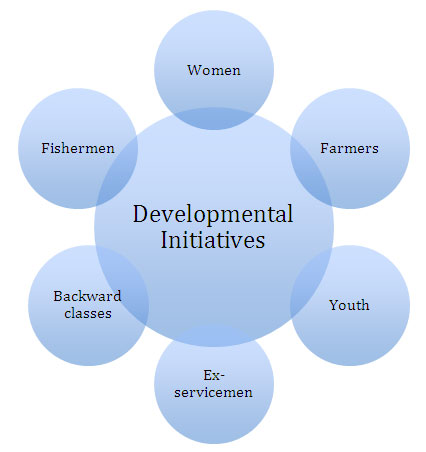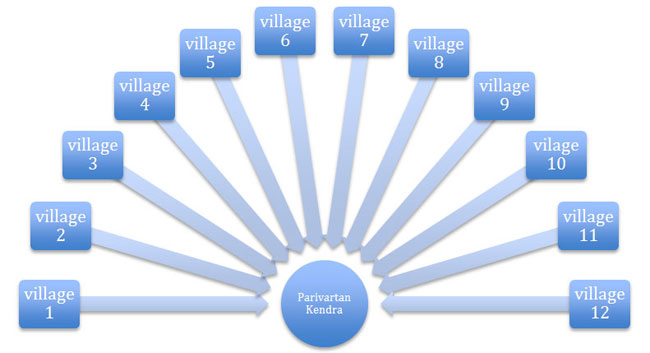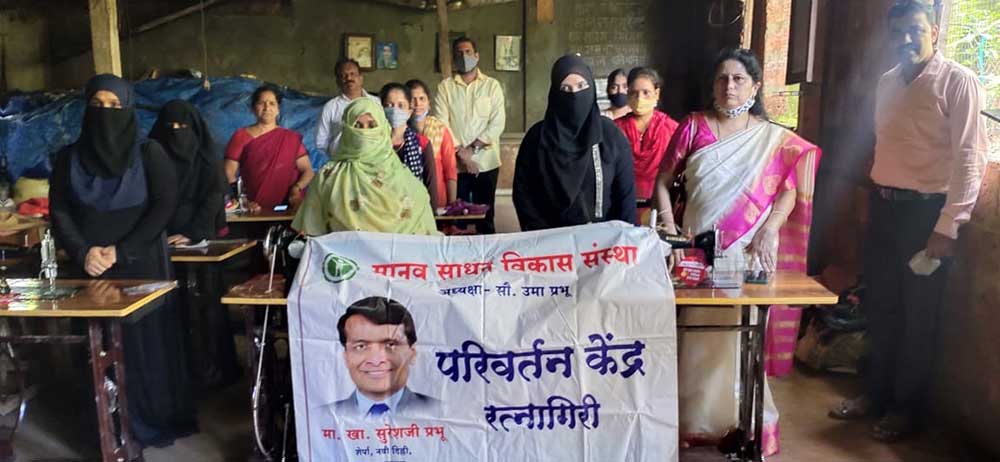Parivartan Kendra
A Parivartan Kendra (PK) is visualized as a hub of developmental activities in a given cluster of villages to ensure an all-round development of the people. It has been perceived as a replicable model/ unit of development with a clearly defined organizational structure for implementing and coordinating programs, and schemes for a given set of target groups at the grass root level.
‘Parivartan Kendra’- A Transformation Centre for Development – An Approach
Development strategies are conceived through a division of population into 6 target groups namely, farmers, women, youth, fishermen, ex-servicemen and backward classes.
Diagram 1. Target Groups

Such stratification helps in clearly defining developmental initiatives for an individual target group. Since the target groups have their representatives at different levels of the organizational structure- from the hamlet up to the district- this helps in better implementation of the welfare activities meant for a given group of people. MSVS believes that merely stressing economic activities is not likely to yield results unless supplemented by efforts in the field of health, education and recreation, and also value education to enrich the lives of the people. Hence MSVS advocates simultaneous development in different sectors to enable the people to get all the benefits of synergy.
Diagram 1. Target Groups

Such stratification helps in clearly defining developmental initiatives for an individual target group. Since the target groups have their representatives at different levels of the organizational structure- from the hamlet up to the district- this helps in better implementation of the welfare activities meant for a given group of people. MSVS believes that merely stressing economic activities is not likely to yield results unless supplemented by efforts in the field of health, education and recreation, and also value education to enrich the lives of the people. Hence MSVS advocates simultaneous development in different sectors to enable the people to get all the benefits of synergy.
Basic Principles & Aim of Parivartan Kendra Model
For comprehensive and sustainable development, the following principles are considered to be the basis: equality, peoples’ participation, co-operation, sharing and self-contribution, along with area-specific grassroots level planning linked to the development needs of the region. It is perceived that this will form a solid foundation for security of livelihood, improve people’s access to productive assets, help in creating economic opportunities which will contribute to promoting social & human development and in turn strengthen Institutional mechanisms.
Organizational Structure
The model revolves around a huge network of NGOs, which while capitalizing on each other’s strengths work synergistically towards a common goal- in this case the holistic development of the grassroots in the Konkan region. MSVS is the mother NGO at the district level, which coordinates the work of 10 Block level Coordinating Committees or BCCs. The BCC are actually reputed NGOs, which have a proven track record and which are on same page as MSVS. At the BCCs there are volunteers for each of the 6 target groups to further interest of their own group. Each BCC services about 10 to 12 PKs, which fall in its area of operation.
A PK is a hub of activities for a given cluster of 10 to 12 villages. Manned by a reputed NGO, a PK has volunteers for the different target groups, who focus on the developmental strategies for their own group in the villages that come under the area of operation of their PK. The core purpose of this effort is to provide economic opportunities and sustainable livelihood to each and every villager at his place of residence itself. The PK also works on the other developmental aspects like health and environment to make the life of the villagers truly meaningful. Each PK seems like stand alone structure but it also is a part of the monolithic network of several NGOs, which provides synergy, strength and organizational support. Initially, there were about 105 PKs, of these only about 46 PKs are now functional. Plans are afoot to revive the non-functional centres.
A PK is a hub of activities for a given cluster of 10 to 12 villages. Manned by a reputed NGO, a PK has volunteers for the different target groups, who focus on the developmental strategies for their own group in the villages that come under the area of operation of their PK. The core purpose of this effort is to provide economic opportunities and sustainable livelihood to each and every villager at his place of residence itself. The PK also works on the other developmental aspects like health and environment to make the life of the villagers truly meaningful. Each PK seems like stand alone structure but it also is a part of the monolithic network of several NGOs, which provides synergy, strength and organizational support. Initially, there were about 105 PKs, of these only about 46 PKs are now functional. Plans are afoot to revive the non-functional centres.
Diagram 2. PK Model (Cluster of 12 villages)

Key Beneficial Elements of Parivartan Kendra Model
A PK acts as a facilitator in:
- Sowing the seeds of association among the people,
- Helping in establishing a link between grassroots level functionaries and community for better ‘community-government’ participation,
- Helping in empowering the poor through advocacy, awareness generation and social mobilization,
- Creating a permanent pipeline through which information about government schemes can reach the people and feedback from the people can reach the government and
- Undertaking monitoring to ensure proper implementation of government schemes in the villages.
Activities at Parivartan Kendras
The PK model works through a hexagon of developmental focuses viz. economic, physical, cultural, socio-spiritual, intellectual and environmental development. The existing well-knit structure and geographically well-dispersed NGOs provide an excellent mechanism for carrying out different activities. A typical PK has:
Jana Shikshan Sansthan, the vocational training institute under the MSVS umbrella, imparts employability skills to the people at the PK contributing to their economic development. Lupin Human Welfare and Research Foundation and National Bank of Agricultural and Rural Development help in Women empowerment through creation of Self Help Groups. SHGs are small informal associations of poor individuals known to each other who come together for a common collective purpose at village level. It is an approach to involve poor people in the developmental process specially in making adequate facilities available to them, out of a self managed pool of money generated through their own savings. Today there is a network of over 2,000 SHGs in the area. Self Help Groups (SHG) for other target groups are also being formed. Ford Foundation has given much help in running an awareness campaign about computer education, and ICICI, MITCON, NIIT and NIC have collectively installed Internet kiosks for the benefit of the people.
- Gymnasium,
- Mobile library,
- STD-PCO facility,
- Internet kiosk,
- Community toilets,
- First-aid centre,
- Mobile hospital,
- Health camps,
- Complaint registration and problem resolving,
- Publicity of government schemes,
- Monitoring the progress of development schemes of government,
- Facilitation centre,
- Branch of a co-operative supermarket/marketing hub,
- Training camps,
- Agriculture activities,
- Training & exposure to the PK coordinators
Jana Shikshan Sansthan, the vocational training institute under the MSVS umbrella, imparts employability skills to the people at the PK contributing to their economic development. Lupin Human Welfare and Research Foundation and National Bank of Agricultural and Rural Development help in Women empowerment through creation of Self Help Groups. SHGs are small informal associations of poor individuals known to each other who come together for a common collective purpose at village level. It is an approach to involve poor people in the developmental process specially in making adequate facilities available to them, out of a self managed pool of money generated through their own savings. Today there is a network of over 2,000 SHGs in the area. Self Help Groups (SHG) for other target groups are also being formed. Ford Foundation has given much help in running an awareness campaign about computer education, and ICICI, MITCON, NIIT and NIC have collectively installed Internet kiosks for the benefit of the people.
Genesis
Situational analysis of the project area brought out the following problems:
- Around one-third of the population living below the poverty line
- Large chunk of the land is fallow
- Irrigation facilities are scanty
- No proper rainwater harvesting
- Landholdings are small
- Lack of attention to animal husbandry resulted into poor milch animals and poor milk storage facilities
- Scope for inland fisheries is limited
- Lack of enterprising attitude among people
- Lack of food processing centres
Prospects for Development in the Project Area
It was found that there was tremendous economic potential and scope for development in following sectors: agriculture, animal husbandry, fisheries, rural cottage industries and tourism. However, there was a pressing need to increase people’s participation in decision-making as well as implementing programmes/ schemes. Development had to be brought about by the total involvement of the people and a comprehensive decentralized package of activities encompassing every aspect of human life was found to be the answer to this problem. It was from this thought process that the concept of Parivartan Kendra came to light.







